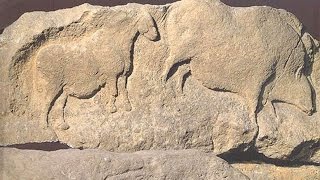From March of the Titans (on Youtube)
An important and rare site of cave art from the Solutrean period, Roc de Sers is a rock shelter and sanctuary situated north of Gachedou, in the Charente. Although it contains a variety of prehistoric art, it is best known for its series of sculpted, engraved and painted limestone blocks, decorated with more than 50 rock engravings and works of relief sculpture, depicting bison, horses and other animals. Prehistorians see Roc de Sers as an important benchmark of Solutrean art, notably in the area of prehistoric sculpture, where the interplay between form, light and shadow seem to have been fully appreciated by the shelter’s artists. Most of the limestone blocks are now part of the permanent collection of Stone Age Art at the French Museum of National Antiquities (Saint-Germain-en-Laye), although copies can be seen at Roc de Sers.
Discovery and Excavation
Located in the vallée de l’Echelle, a tributary of the Touvre, the site of Roc de Sers was excavated in 1908 by A. Favraud and by Dr. Henry Martin from 1917. The first elements of the sculpted frieze of Roc de Sers were discovered in 1927 by Dr. Henry-Martin. These excavations were interrupted in 1933. Other carved items were discovered in 1951 by R. Lantier and Mlle G. Henry-Martin.
Dating
Excavations of the embankment downstream of the shelter has yielded artifacts and sediments from various occupations dating back to between 18,000 and 15,000 BCE. Artifacts recovered include “feuilles de laurier”, shouldered points, willow points, burins, scrapers, grattoirs and blades. The worked material is mainly flint, but rock crystal, quartz and quartzite were also used. The discovery of large clusters of small stone chips suggests the presence of lithic workshops.
The date of the sculpted limestone slabs can be confidently attributed to the Solutrean era, about 17,200 BCE, as they collapsed into precisely dated archeological deposits. Contemporaneous sites of Franco-Cantabrian cave art include: Le Placard Cave (17,500 BCE), noted for its peculiar abstract signs; the world-renowned Lascaux Cave paintings (from 17,000 BCE); and the La Pasiega Cave art (16,000 BCE) in Puente Viesgo, Spain.
Source Article from http://www.renegadetribune.com/roc-de-sers-solutrean-art-17500-years-ago/
 RSS Feed
RSS Feed















 June 20th, 2017
June 20th, 2017  Awake Goy
Awake Goy 
 Posted in
Posted in  Tags:
Tags: 













